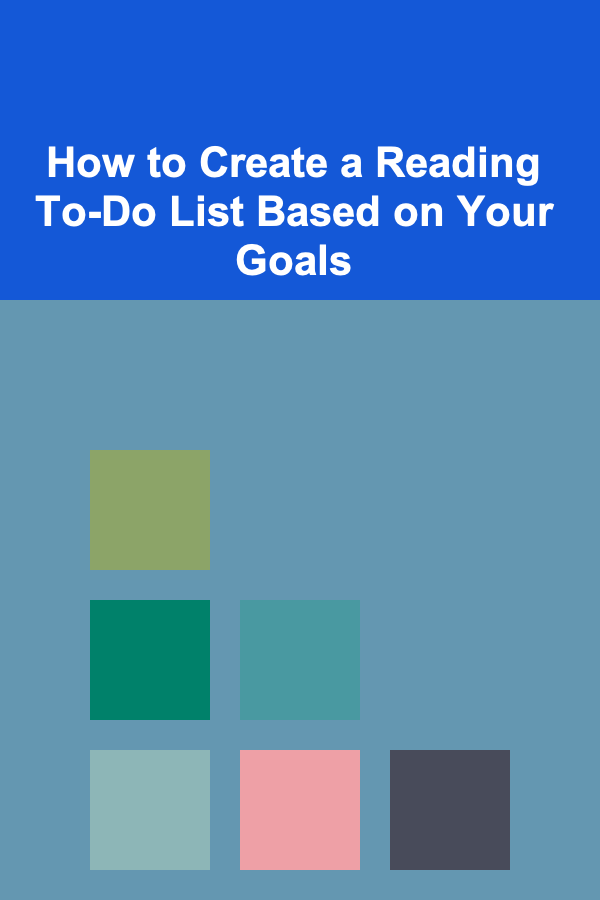
How to Create a Reading To-Do List Based on Your Goals
ebook include PDF & Audio bundle (Micro Guide)
$12.99$9.99
Limited Time Offer! Order within the next:

Reading is a powerful tool for personal and professional growth, yet the vast array of books and resources available can feel overwhelming. Whether you're aiming to develop new skills, expand your knowledge, or simply enjoy the pleasure of reading, having a structured reading plan can make all the difference. A reading to-do list based on your goals ensures that every book you pick up aligns with what you want to achieve, making your reading experience more purposeful and enriching.
In this article, we'll explore how to create a personalized reading to-do list that matches your goals, providing clarity and focus to your reading journey.
Step 1: Identify Your Primary Goals
Before you can create a meaningful reading to-do list, it's essential to determine your overarching goals. What do you want to achieve through reading? Your goals will guide the selection of books and help you stay on track.
Here are a few categories of goals that can influence your reading choices:
Personal Development
- Developing self-awareness, emotional intelligence, and mental resilience.
- Learning time management, decision-making, and goal-setting techniques.
- Building positive habits and breaking negative ones.
Professional Development
- Gaining expertise in a specific field or industry.
- Improving soft skills such as leadership, communication, or team collaboration.
- Staying updated with trends, technologies, and best practices.
Academic or Educational
- Deepening your knowledge in a particular subject area or discipline.
- Preparing for exams, certifications, or formal qualifications.
- Enhancing critical thinking, research, or analytical skills.
Hobby or Passion
- Exploring personal interests like art, history, travel, or fiction.
- Delving into creative pursuits such as writing, photography, or cooking.
- Broadening cultural or literary knowledge.
Entertainment and Relaxation
- Reading for fun, stress relief, or escapism.
- Exploring different genres, such as fantasy, mystery, or historical fiction.
- Reading to unwind before bed or during leisure time.
Social Impact
- Learning about global issues, social justice, or environmental sustainability.
- Exploring biographies, histories, or other non-fiction genres that broaden your perspective.
- Engaging with books that inspire change and action.
Step 2: Break Down Your Goals into Sub-Goals
Once you've identified your main goals, the next step is to break them down into actionable sub-goals. These sub-goals will help narrow down the scope of your reading list and ensure that the books you select directly contribute to your objectives.
For example:
-
Personal Development Goal: Improve emotional intelligence.
- Sub-goal 1: Learn how to manage stress and stay calm under pressure.
- Sub-goal 2: Understand the dynamics of empathy and how to apply it in conversations.
- Sub-goal 3: Strengthen self-awareness through introspection and mindfulness.
-
Professional Development Goal: Enhance leadership skills.
- Sub-goal 1: Learn strategies for effective communication in leadership roles.
- Sub-goal 2: Understand team dynamics and how to motivate others.
- Sub-goal 3: Explore how to manage conflict and make strategic decisions.
By breaking down larger goals into specific sub-goals, you can better align your reading choices to meet those objectives in a manageable and incremental way.
Step 3: Curate a List of Books for Each Sub-Goal
With your sub-goals in mind, you're now ready to start selecting books. Each sub-goal should have a set of books that are tailored to help you achieve it. There are many ways to find books that align with your interests, such as:
- Online Book Recommendations: Websites like Goodreads, Amazon, and various blogs feature curated lists and reviews that can guide you to the right books.
- Book Clubs and Reading Groups: Many online and offline communities focus on specific genres or topics, offering book suggestions that align with common goals.
- Expert and Thought Leader Recommendations: Look for books recommended by leaders in the field you're focusing on, whether it's self-improvement, leadership, or technology.
- Library and Bookstore Sections: Exploring your local library or bookstore can also be a great way to discover books relevant to your goals.
Example List for Emotional Intelligence Goal:
- The Power of Now by Eckhart Tolle (on mindfulness and self-awareness)
- Emotional Intelligence 2.0 by Travis Bradberry and Jean Greaves (on improving emotional intelligence)
- The Gifts of Imperfection by Brené Brown (on vulnerability, courage, and empathy)
Example List for Leadership Development Goal:
- Leaders Eat Last by Simon Sinek (on leadership and creating a culture of trust)
- The Five Dysfunctions of a Team by Patrick Lencioni (on effective teamwork)
- Drive by Daniel H. Pink (on motivation and leadership in the workplace)
Step 4: Organize Your Reading List
Now that you have a curated list of books, it's time to organize them into a reading to-do list that suits your schedule and priorities. Consider the following steps:
Prioritize Your Goals
Start by identifying which goals are most urgent or important to you. If you're looking to improve your leadership skills to advance in your career, prioritize books that will help you with this goal. If personal development is your top priority, start with books that address emotional intelligence and self-awareness.
Create a Reading Timeline
Set a realistic timeline for completing each book. Depending on the complexity of the book, you can allocate more or less time to it. You might choose to read one book per month or dedicate a set number of hours per week for reading. This will help you stay on track and prevent overwhelm.
For example, you could read:
- The Power of Now in 3 weeks
- Leaders Eat Last in 4 weeks
- Emotional Intelligence 2.0 in 2 weeks
Mix Fiction and Non-Fiction
If you're aiming for both personal and professional growth, balance your reading list with a mix of fiction and non-fiction. Non-fiction books will directly contribute to your learning goals, while fiction can provide relaxation and a creative outlet. Having a variety of genres will keep your reading journey enjoyable and prevent burnout.
Include Different Formats
Books come in many formats beyond physical copies. E-books, audiobooks, and podcasts can all be great alternatives when you're on the go or need a change in medium. If you struggle to find time to read, audiobooks can help you stay on track while commuting, exercising, or completing other tasks.
Step 5: Set Realistic Reading Goals
Reading is a habit, and like any habit, it requires consistency. Setting small, manageable goals will help you build momentum. Consider the following tactics for setting realistic reading goals:
Daily or Weekly Goals
- Daily Goal: Read for 20-30 minutes each day. This is often a more manageable approach for those with a busy schedule.
- Weekly Goal: Set a target number of pages or chapters to complete each week.
Track Your Progress
Use apps like Goodreads or a simple journal to track your progress. Record the books you've finished, rate them, and reflect on what you learned. Tracking your progress helps maintain motivation and provides a sense of accomplishment.
Step 6: Review and Adjust Your List Periodically
Your goals and priorities may change over time, and so should your reading list. Periodically review your list to ensure it's still aligned with your objectives. You might find that you need to adjust your reading to include books on a new topic or skill that has become relevant to your life or career.
Step 7: Apply What You Learn
Reading is not just about finishing books---it's about applying the knowledge you gain. After each book, take time to reflect on the key takeaways and how you can apply them to your daily life. For instance, after reading a book on leadership, implement the strategies you learned at work or within your community.
Additionally, consider sharing what you've learned with others. Teaching or discussing concepts with friends, colleagues, or online communities will deepen your understanding and reinforce your learning.
Conclusion
Creating a reading to-do list based on your goals is an effective strategy for ensuring that your reading time is spent meaningfully and efficiently. By setting clear objectives, breaking them into manageable sub-goals, and curating a personalized reading list, you can transform reading from a passive activity into a powerful tool for personal and professional growth. Keep track of your progress, adjust your list as needed, and apply what you learn to enhance your life and work. Happy reading!
Reading More From Our Other Websites
- [Personal Investment 101] How to Set Competitive Rental Rates
- [Organization Tip 101] How to Create a Daily Cleaning Checklist for Your Home
- [Home Staging 101] How to Stage Your Home for Buyers with Young Families
- [Star Gazing Tip 101] Pocket Planetarium: How to Capture Stunning Star Photos with Your Phone
- [Home Security 101] Best Home Security Alarms: Fast Response and Advanced Technology
- [Home Storage Solution 101] How to Store Your Christmas Lights and Decorations Efficiently
- [Beachcombing Tip 101] Spotting Sand Dollars: How to Identify These Ocean Gems on the Beach
- [Home Party Planning 101] How to Incorporate Seasonal Decor Into Your Home Party Planning
- [Organization Tip 101] Why Organizing Your Home Can Boost Your Mental Health
- [Home Budget Decorating 101] How to Create a Farmhouse Look on a Budget

How to Clean and Organize Your Fridge for Maximum Efficiency
Read More
How to Create a Quiet Space in Your Open Floor Plan Home
Read More
How to Pack for a Digital Detox Vacation: A Checklist for Disconnecting
Read More
How to Plan a Themed Party for Adults
Read More
How to Refinance Your Mortgage for Better Budget Control
Read More
How to Select and Style Vases and Bowls: A Comprehensive Guide
Read MoreOther Products

How to Clean and Organize Your Fridge for Maximum Efficiency
Read More
How to Create a Quiet Space in Your Open Floor Plan Home
Read More
How to Pack for a Digital Detox Vacation: A Checklist for Disconnecting
Read More
How to Plan a Themed Party for Adults
Read More
How to Refinance Your Mortgage for Better Budget Control
Read More